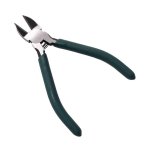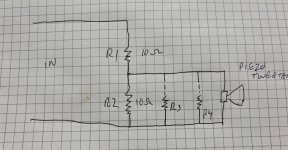I scrapped a pair of Eltax floorstanders. Got good money for the dome tweeters. The cabinet is fairly robust so I threw in some drivers I had lying around. The Sony woofers sound okay (possibly better than the originals).
The $3 piezo bullet tweeters sound like exactly what they are - cheap and nasty.
I think the crossover point is 2.7khz.
Piezo inductance is all Greek to me. Anything I can do negate the lower HF screaming?
I'm not going to spend any money. These boxes will spend the summer in the garden pumping out tunes for our barbecues. When the weather turns cold - they are done.

The $3 piezo bullet tweeters sound like exactly what they are - cheap and nasty.
I think the crossover point is 2.7khz.
Piezo inductance is all Greek to me. Anything I can do negate the lower HF screaming?
I'm not going to spend any money. These boxes will spend the summer in the garden pumping out tunes for our barbecues. When the weather turns cold - they are done.
Last edited by a moderator:
What you need to know is contained within this document: https://www.frugal-phile.com/piezo-XO.html
P.S. Piezos don't have inductance, they have capacitance.
P.S. Piezos don't have inductance, they have capacitance.
In this circuit, to suit your small piezo tweeters, experiment with 1.5 uF and 2.2 uF series capacitors.
The parallel resistor is always 22 ohm.

The parallel resistor is always 22 ohm.
You are no doubt running the piezo off the the HF section of the original Eltax crossover. In that case it may be sufficient simply to add the 22 ohm shunt resistor. I would try that out on one speaker first in order to allow comparison with the undoctored speaker.
I don't think a high power handling is required - a 22 ohm, 5 W resistor should be enough - but you can use a smaller wattage resistor (or combination of resistors) for experimentation purposes.
I don't think a high power handling is required - a 22 ohm, 5 W resistor should be enough - but you can use a smaller wattage resistor (or combination of resistors) for experimentation purposes.
Last edited:
Okay. I don't have any power resistors on hand. Will adding the series capacitors on their own make any difference?
Existing 4.7 + 2.2 = 1.5
Is that correct?
Existing 4.7 + 2.2 = 1.5
Is that correct?
Will adding the series capacitors on their own make any difference?
There's nothing to stop you finding out by doing an experiment. Let your ears decide.
However the shunt resistor is the way to go - time to splash the cash!
P.S. Your calculation is correct.
Piezos tend to be very sensitive or more efficient than other driver types so they just play louder, as you have heard.Piezo inductance is all Greek to me. Anything I can do negate the lower HF screaming?
I used a simple resistor based voltage divider to reduce the volume to match the woofer by listening trials.
Start with only R1 & R2 and see how it sounds. It will be lower.
If still too loud, add R3 and try again.
Repeat with R4 if needed.
Yes you could do all the math to calculate the values for just a 2 resistor divider, but then you need to buy many different values.
I've done this with 4 different designs and each one needed a different amount, but all resistors were 10 Ohm, 2 watt.
I did the wiring with a screw type terminal strip.
Attachments
Thanks. Tried it.
Amy Winehouse' vocal is no longer hurting my ears but drum 'n' bass percussion sounds very scratchy.
But you are right: laboratory testing & simulation is so overrated. Subjective & in situ is where the proof is at.
20-30 people in the garden on Sunday - see how sounds then.
Amy Winehouse' vocal is no longer hurting my ears but drum 'n' bass percussion sounds very scratchy.
But you are right: laboratory testing & simulation is so overrated. Subjective & in situ is where the proof is at.
20-30 people in the garden on Sunday - see how sounds then.
Practically will "do nothing"Okay. I don't have any power resistors on hand. Will adding the series capacitors on their own make any difference?
Existing 4.7 + 2.2 = 1.5
Is that correct?
We are adding an RC circuit to tame Piezo.
No R no RC
Imagine you ask for a cup of coffee, waiter brings the empty cup only and asks : "will this do?" 🙂
I had piezo tweeter in my bass combo and fixed it quickly with these:

Another quick fix for piezo tweeter is to tape a pillow over it. Our band first PA had both piezos broken, so I guess another quick fix is to crank the amp to smokem'. Third one is to leave the speaker on the curb for next person so that they can figure out what to do with it.
I got very little experience on piezos so this post is mostly for humor, but all that I have was just scream and the systems sounded better without. I bet there is no cheap / fast fix for the issue, otherwise there wouldn't be this problem. Piezo systems are fast and cheap, if it was cheaper to fix the scream than replace with a compression driver, they would have.

Another quick fix for piezo tweeter is to tape a pillow over it. Our band first PA had both piezos broken, so I guess another quick fix is to crank the amp to smokem'. Third one is to leave the speaker on the curb for next person so that they can figure out what to do with it.
I got very little experience on piezos so this post is mostly for humor, but all that I have was just scream and the systems sounded better without. I bet there is no cheap / fast fix for the issue, otherwise there wouldn't be this problem. Piezo systems are fast and cheap, if it was cheaper to fix the scream than replace with a compression driver, they would have.
Last edited:
I got very little experience on piezos so this post is mostly for humor
It did make me giggle! 😊
As mentioned above, you will need the resistors. It will be way more efficient than your woofers and will need padding down.
Practically will "do nothing"
We are adding an RC circuit to tame Piezo.
No R no RC
Imagine you ask for a cup of coffee, waiter brings the empty cup only and asks : "will this do?" 🙂
I'm not going to blindly follow instructions. I'm working with what I have to hand.
If the Piezo's impedance is 30 ohms @ 5khz does the 1.5mf capacitor increase resistance at that frequency?
To improve your analogy: Imagine asking the waiter for a glass of cow's milk with a teaspoon of sugar. The waiter tells you they've got no sugar & suggests you try almond milk as it's sweeter than cow's milk.
If the Piezo's impedance is 30 ohms @ 5khz does the 1.5mf capacitor increase resistance at that frequency?
The capacitive reactance of a 1.5 uF capacitor at 5 kHz is 21 ohm.
What do you conclude from that information?
The capacitive reactance of a 1.5 uF capacitor at 5 kHz is 21 ohm.
What do you conclude from that information?
It's not ideal but every little helps? I was never seeking perfection, just looking to take the edge off. It was a zero-cost (actually negative-cost) project.
As indicated by you, ultimately it's about what I hear. To my ear, it sounds better. Perhaps it's the placebo effect - perhaps not.
You will have much more success with the resistor voltage divider than with caps.
I know you said you don't have any resistors, but they are cheap and easy to get.
I speak from experience - I have actually done this several times with succes.
I know you said you don't have any resistors, but they are cheap and easy to get.
I speak from experience - I have actually done this several times with succes.
It's not ideal but every little helps?
I don't see how your suggestion could help at all. That's why I suggested you try it so you could judge for yourself.
If you think you heard a positive difference then just wait till you fit that 22 ohm parallel resistor! 😉
I was given a pair of KEFs with blown tweeters. Originals are unobtainium so I opted for a pair of cheapo "super" tweeters. They were way too fierce and set my teeth on edge. My solution was to bang in a pair of L-pads to tame the nasty tweets. On the down side, they were expensive.
For the record:
Simply relying on their inherent capacitive reactance to roll them off at the bottom means piezos can get fairly ugly sounding in their lower ranges and will often make the amplifier unstable making everything sound bad. Therefore direct connection to the speaker's input terminals is best avoided.
The RC circuit shown in post #3 rolls off the low frequencies (say below 1 kHz) at 6 dB/octave.
This increases the power handling of the piezo. Add in a capacitor and 22 ohm resistor, and the power handling could effectively be quadrupled, as the LF voltages are not imposed upon the piezo, just the HF voltages. The result is cleaner sound.
P.S. I have edited information contained within the link in post #2.
Simply relying on their inherent capacitive reactance to roll them off at the bottom means piezos can get fairly ugly sounding in their lower ranges and will often make the amplifier unstable making everything sound bad. Therefore direct connection to the speaker's input terminals is best avoided.
The RC circuit shown in post #3 rolls off the low frequencies (say below 1 kHz) at 6 dB/octave.
This increases the power handling of the piezo. Add in a capacitor and 22 ohm resistor, and the power handling could effectively be quadrupled, as the LF voltages are not imposed upon the piezo, just the HF voltages. The result is cleaner sound.
P.S. I have edited information contained within the link in post #2.
Last edited:
The point is that a Piezo is a capacitor (I measured .68uF , .89uF, .52uF, etc.) depending on brand.It's not ideal but every little helps? I was never seeking perfection, just looking to take the edge off. It was a zero-cost (actually negative-cost) project.
As indicated by you, ultimately it's about what I hear. To my ear, it sounds better. Perhaps it's the placebo effect - perhaps not.
A capacitor in series with another capacitor "equalizes" nothing, only adds (tiny) attenuation, a fraction of a dB, completely undetectable by ear.
Meaning it will NOT get rid of any peak.
Any perceived sound difference does not come from the added capacitor.
Like it or not, you need a resistor there to introduce a crossover point; to attenuate below a certain frequency, hopefully to get rid (or attenuate) the NASTY 3-4kHz peak all show.
Otherwise attenuation is ruler flat across full bandwidth (i.e. no peak taming).
- Home
- Loudspeakers
- Multi-Way
- Taming screaming piezos. Any quick & dirty tips?
